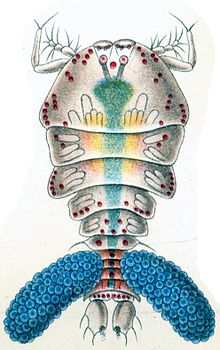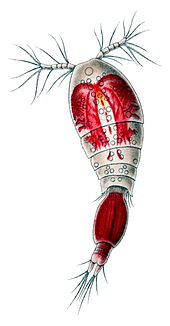Poecilostomatoida
This article needs to be updated. The reason given is: Poecilostomatoida was renamed to Ergasilida in 2019 (https://www.marinespecies.org/aphia.php?p=taxdetails&id=1103); the paper proposing this revised phylogeny (https://www.ncbi.nlm.nih.gov/pmc/articles/PMC5567239/) has since been retracted.. (October 2023) |
| Poecilostomatoida | |
|---|---|

| |
| Sapphirina darwinii with egg cases | |
| Scientific classification | |
| Domain: | Eukaryota |
| Kingdom: | Animalia |
| Phylum: | Arthropoda |
| Class: | Copepoda |
| Order: | Cyclopoida |
| Suborder: | Poecilostomatoida Thorell, 1859 |
| Families | |
|
See text | |
Poecilostomatoida is a suborder of
Description
The classification of these copepods has been established on the basis of the structure of the mouth. In poecilostomatoids the mouth is represented by a transverse slit, partially covered by the overhanging labrum which resembles an upper lip. Although there is variability in the form of the mandible among poecilostomatoids, it can be generalized as being falcate (sickle-shaped).[1][2]
The
Life cycle
As with many crustaceans, larval development is metamorphic with immature forms differing greatly from those of adults. Embryos are carried in paired or single sacs attached to first abdominal somite (as seen in the illustration of the female Sapphirina darwinii above right).[4][5]
Ecology
Most poecilostomatoid copepods are
In addition to typical marine environments, poecilostomatoid copepods may be found in such very particular

List of families
There are over sixty families currently recognized within the group:[8]
- Abrsiidae
- Anchimolgidae
- Anomoclausiidae
- Antheacheridae
- Anthessiidae
- Bomolochidae
- Bradophilidae
- Catiniidae
- Chondracanthidae
- Clausidiidae
- Clausiidae
- Corallovexiidae
- Corycaeidae
- Echiurophilidae
- Entobiidae
- Erebonasteridae
- Ergasilidae
- Eunicicolidae
- Gadilicolidae
- Gastrodelphyidae
- Herpyllobiidae
- Intramolgidae
- Iveidae
- Jasmineiricolidae
- Kelleriidae
- Lamippidae
- Leaniricolidae
- Lichomolgidae
- Lubbockiidae
- Macrochironidae
- Makrostrotidae
- Mesoglicolidae
- Myicolidae
- Mytilicolidae
- Nereicolidae
- Octopicolidae
- Oncaeidae
- Paralubbockiidae
- Philichthyidae
- Philoblennidae
- Phyllodicolidae
- Pionodesmotidae
- Polyankyliidae
- Pseudanthessiidae
- Rhynchomolgidae
- Sabelliphilidae
- Saccopsidae
- Sapphirinidae
- Serpulidicolidae
- Shiinoidae
- Spiophanicolidae
- Splanchnotrophidae
- Strepidae
- Synapticolidae
- Synaptiphilidae
- Taeniacanthidae
- Telsidae
- Thamnomolgidae
- Tuccidae
- Umazurcolidae
- Urocopiidae
- Vahiniidae
- Ventriculinidae
- Xarifiidae
- Xenocoelomatidae
References
- ^ .
- ^ a b c d e f Joel W. Martin & George E. Davis (2001). An Updated Classification of the Recent Crustacea (PDF). Natural History Museum of Los Angeles County. p. 132.
- |intentional=yes}}.)
- ^ J. K. Lowry (October 2, 1999). "Crustacea, the Higher Taxa: Description, Identification, and Information Retrieval". Archived from the original on March 20, 2019. Retrieved January 22, 2007.
- ^ "Introduction to Copepods" (PDF). University of Connecticut. Archived from the original (PDF) on May 13, 2008.
- hdl:10088/5504.
- ^ a b "Introduction to Copepods" (PDF). University of Connecticut. Archived from the original (PDF) on 2008-05-13. Retrieved 2007-01-22.
- ^ Geoff Boxshall, & T. Chad Walter (2019). T. Chad Walter & Geoff Boxshall (ed.). "Poecilostomatoida". World Copepoda database. World Register of Marine Species. Retrieved May 19, 2019.
External links
 Data related to Poecilostomatoida at Wikispecies
Data related to Poecilostomatoida at Wikispecies Media related to Poecilostomatoida at Wikimedia Commons
Media related to Poecilostomatoida at Wikimedia Commons

